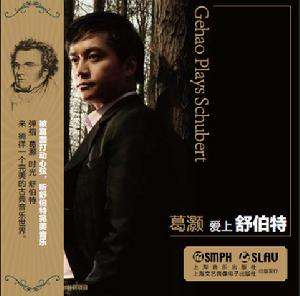 封面
封面專輯收錄:
著名青年鋼琴家葛灝的全新個人專輯.
舒伯特(Schubert)的《第16號鋼琴奏鳴曲》(Piano Sonata No.16 in A minor, D845),A小調,D845,作於1825年,呈獻給魯道夫大公(貝多芬的《大公三重奏》也是獻給他)。
樂曲共4個樂章:1.中板,A小調,奏鳴曲式。中聲部的八度進行使人感到一絲淒涼和空洞,副部主題出現後產生強烈對比,使得該樂章極具戲劇性,最後在痛苦而悲壯的情緒中結束。2.稍快的行板,小步舞曲C大調,變奏曲式。此樂章中的五段變奏,表現出作曲家豐富的創作手法和多變的心情。3.諧謔曲,活潑的快板,A小調。運用優美的中段和前後兩段主題的強烈對比,表現出自然的活力和寧靜。4.迴旋曲,活潑的快板,A小調,作曲家用一連串的八分音符,表現了一種連綿不斷和無窮動的感覺,讓人感到無窮的活力。
C大調幻想曲"流浪者"(C-major FANTASIE "Wanderer")作於1822年。這首作品鏇律,和聲極為豐富,而且演奏難度相當大,舒伯特自己都不能演奏好,當時舒伯特為練習演奏此曲花了很大工夫,但都不能達到他滿意的效果,於是憤怒地將樂譜扔在地上說:“我再也不演奏它了!!!”。確實,豐富的鏇律與輝煌的音響效果使得此曲成為音樂會的常見曲目。此作品由激昂的和弦引出藝術歌曲《流浪者》的主題,開始了一段對話式的戲劇性音樂表述,緊接著出現第二樂章優美而寧靜的鏇律,似乎是作曲家內心孤獨和淒涼的表白。第三樂章充滿著活力,讓人感受到了一個孤獨的流浪者短暫的快樂。隨後第四樂章在貝多芬式的輝煌中結束了全曲,表達了作曲家與命運抗爭的決心。
About the Pieces
A minor Piano Sonata (D845,No.16) was composed in 1825, dedicated to the archduke Rudolph(to whom Beethoven’s trioArchduke,Op.97 presented ).
The piece is made up of four movements: 1, Moderato, A Minor, sonata. The octave processing in the middle passage which shows a ghost of loneliness and emptiness is sharply against the second theme, hence creates the dramatic effect of the movement. It ends in a painful and solemn tune. 2, Andante mosso, minute, C Major, variation. The five passage of variation reflects the various ways of composition and the complex emotion.3, scherzo, allegro vivace, A Minor. The contrast between the beautiful middle passage with the earlier and the following passage displays the vitality and peace of nature.4, Rondo, allegro vivace, A Minor. With using a succession of quavers, the composer represents the sense of continuousness and inexhaustibleness which wakes up one’s endless energy.
Fantasia in C Major (“Wanderer”) was written in 1822. The piece is rich in melody and harmony. But it is also hard to play, even the composer himself can’t be satisfied with his performance, although he had has worked very hard with it. He threw the sheet to the floor angrily and said:”I would never play it again!” That is true that the work is the favorite repertoire in the concert with the challenged technique as well as the varied melody and splendid effect. It begins with the theme of the song “Wanderer”, followed with the dramatically musical description in a way of dialogue. The beautiful melody of the second movement coming up immediately, it seems like a monolog of the composer’s lonely heart. The third movement is full of vitality and shows the short happiness of wanderer. Finally, the piece ends with the Beethoven’s brilliant in the last movement which expresses the composer’s determination to striving against the destiny.
上市時間:
2009年3月16日,<愛上舒伯特>專輯的錄製工作,在上海聲像公司錄音棚里順利開始。2009年4月中旬錄製完畢. 2009年5月中旬完成後期製作, 目前已經全面上市.
葛灝簡介:
上海市科委浦江人才計畫科研項目
葛灝,生於上海,旅德青年鋼琴家,歐洲國際音樂節特邀華人鋼琴家。現任上海音樂學院鋼琴系講師並擔任上海音樂學院鋼琴考級常任評審。2006年曾赴各地舉辦專家講座和鋼琴獨奏音樂會。2007年在新疆成功舉辦個人巡演,獲得極大成功。2007年獲得上海市浦江人才計畫專項基金和上海市優秀高校青年教師稱號。
葛灝曾在2002年至2004年旅德留學期間, 多次接受歐洲國際音樂節的邀請舉辦個人鋼琴演奏會, 完美的演奏徹底折服了歐洲聽眾,在03年音樂節期間一舉獲得音樂會金獎,並成為該音樂節指定特邀的華人鋼琴家。此後,
歐洲媒體評論道: “葛灝的音樂震撼每一位聽眾的心靈,完美的音樂感覺及無法挑剔的演奏技術, 讓人難以置信並不得不深深投入到他的古典音樂世界裡…”。在此期間葛灝亦回上海成功舉辦了多次個人鋼琴演奏會,2004年回到母校上海音樂學院鋼琴系,在教學期間潛心研究舒伯特鋼琴作品的演奏,同時對德奧作品及古典音樂普及進行專項研究。此專輯就是多年研究的成果之一,收錄了舒伯特鋼琴奏鳴曲D845和《流浪者幻想曲》兩首技術難度高、音樂內涵深刻的作品。
About the Performer
Ge Hao, a young pianist from Shanghai with German studying background, the special invited Chinese musician of the European International Music Festival, piano teacher of Shanghai Conservatory of Music and permanent examiner for Piano Examine of Shanghai Conservatory of Music. In 2006, He gave many lectures and piano recitals in several regions in China. In 2007, his touring concerts in Xinjiang Province achieved great success. At the same time, he was rewarded with a specific found of Shanghai Pu Jiang Talents Plan and the honor of Finest Young Teacher of Shanghai Universities.
In 2002-2004, Ge Hao studied piano lesson in German. During this time, He was often invited to the European International Music Festival to give personal piano concerts, and the audience was deeply convinced with his perfect performance. In the Festival of 2003, he won the golden medal and was appointed the special invited Chinese pianist. Later, the pianist who has acquired wide attention gave his piano recitals in the country like Germany, Holland, Spain, and Argentina with great success. The European media wrote:”Ge Hao’s performance shocked every listener, his perfect music feeling and unquestionable technique led us into his classic music world…” In this time, Ge Hao also came back to Shanghai to give several welcomed piano concerts. In 2004, he got the position as a piano teacher in his Alma Mater, Shanghai Conservatory of Music. He began to study the Schubert’s piano works as well as fostered the German-Austrian Music. This recording is one of his achievements in recent years. Including with two Schubert’s works, the technique challenged and meaningfulA Minor Piano Sonata(D845, No.14)and Fantasia(“Wanderer”,D760).
舒伯特簡介:
弗朗茲·彼得·舒伯特(Franz Peter Schubert)(1797-1828),生於維也納的一個教師家庭。作為早期浪漫主義音樂的傑出代表,他生前受歧視,死後才得到很高的評價,成為和莫扎特、貝多芬並列的音樂大師。
舒伯特是奧地利傑出的作曲家,他採用和聲上的色彩變化,用各種音樂體裁形式來刻畫個人的心理活動,富有大自然的和諧和生命力的氣息,他將瞬息間的遐想行之于樂譜,把感受到的一切化為音樂形象,構成了他獨特的浪漫主義的鏇律。他對後來浪漫主義音樂的發展起到了極其深遠的影響。
舒伯特短暫的一生十分清貧,大部分時間靠偶然賺點稿費和親戚朋友的接濟度日。雖然他三十一歲就去世了,但卻給後人留下了大量的音樂財富,尤以歌曲著稱,被稱為“歌曲之王”。在他十八年緊張不間斷的創作活動中,舒伯特共完成了一千一百多部作品,包括十四部歌劇、九部交響曲、一百多首合唱曲、五百六十七首歌曲等。其中最著名的有:《未完成交響曲》、《C大調交響曲》、《死神與少女》四重奏、《鱒魚》五重奏、聲樂套曲《美麗的磨坊姑娘》、《冬之旅》及《天鵝之歌》、劇樂《羅莎蒙德》等。
舒柏特生活在古典主義和浪漫主義的交接時期。他的交響性風格繼承的是古典主義的傳統,但他的藝術歌曲和鋼琴作品卻完全是浪漫主義的。他絕妙的抒情性使李斯特稱他為"前所未有的最富詩意的音樂家"。
舒柏特在傳統的室內樂中注入了自己的精神特性。他的室內樂作品都帶有真正的舒柏特的印記,它們也是維也納古典主義的最後一批作品。而在"即興曲"和"音樂瞬間"中,舒柏特使鋼琴唱出了新的抒情風格。它們的隨想性、自發性和意料不到的魅力都成了浪漫主義的要素。
舒柏特最廣為流傳的是他的六百多首歌曲。這些歌曲都是從詩的內心情感中直接產生出來的,沒有人能勝過他那洋溢的才華和清新的情感。鋼琴伴奏也產生了特殊的效果:用一兩個小節描繪出潺潺小溪,街頭藝人破舊的手搖風琴,或是"天堂門前"的雲雀。談到舒柏特的歌曲,可以引用舒曼對《C大調交響曲》的評論:"這種音樂把我們引入一種境地,使我們忘卻了以前曾有過的東西。"
About the Composer
Franz Seraph Peter Schubert was born on January 31,1797. His father was a poor director of primary school in Vienna. He learned piano and violin when he was a child. At the age of 11, he was recruited into the choir of Empire Church, and stayed in the seminary. Soon after, Schubert became the violinist and conductor of the school orchestra which made him the chance to know the famous works of Vienna Classical Music Style. By 1813, he composed the First Symphony. Unfortunately, just in this year, he left the school with the cause of mutation. In order to reduce the family’s economic burden, Schubert took the position as an assistant in his father’s school and continued his composition.
On October 19, 1814, Schubert wrote the music for Gothe’s poet Gretechen am Spinnrade. This master piece, also his first lied, opened out his multiple song music creation. Only in 1815, Schubert composed totally 144 songs, in a day of October, 8 songs came out. Besides, there were one symphony, two masses and other works. In 1816, he quit the job of teacher and devoted himself to composition. The unstable income and the miserable living state affected his work, so the emotion of pain and oppression can often be found within it. Even now, he passionately wrote many excellent works as the tribute to national liberation. However, the long runs of hardship destroyed his health and spirit. On November 19, 1828, he died in Vienna, only was 31 years old. He was respectfully buried alongside with the Beethoven’s grave.
Although a short lifetime as Schubert was, he left us an abundant music treasures. More than 600 songs dazzled in the world music repertoires. So Schubert was acknowledged as the “King of Songs”. The most representative of his songs is Erkönig(D328), Heidenroslein(D257),Ave Maria(D839), Die Forelle(D550),Der Lindenbaum(from Winterreise),Ständchen(D920), and two song cycles Die Schöne Müllerin(D795) and Winterreise(D911). Other works included 18 operas, Singspielsand incidental music, 10 symphonies, 19 quartets, 22 piano sonatas, 4 violin sonatas.
